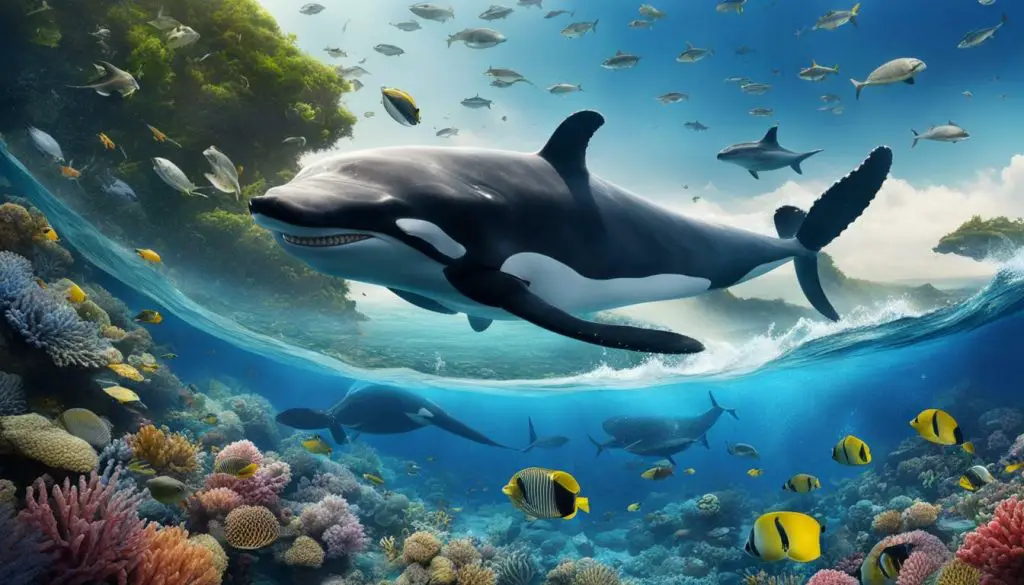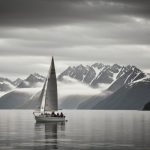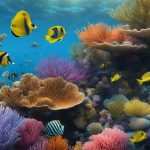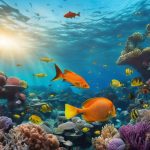Marine ecosystems cover more than two-thirds of our planet and are an essential part of our lives. They provide us with food, oxygen, and countless other resources. However, human activities such as overfishing, pollution, and habitat destruction have put immense pressure on these ecosystems, threatening their health and sustainability. To address these issues, marine conservation zones have been established to protect and preserve marine biodiversity and habitats.
In this comprehensive guide, we will delve into the concept of marine conservation zones, their importance, and the strategies and practices employed in their establishment and management. We will explore the specific efforts made to conserve marine biodiversity and habitats within these zones and examine the challenges and threats faced by them.

Key Takeaways
- Marine conservation zones are established to protect and preserve marine ecosystems.
- Human activities have put immense pressure on marine ecosystems, threatening their health and sustainability.
- Marine conservation zones employ various strategies and practices in their establishment and management.
- Efforts are made within marine conservation zones to conserve marine biodiversity and habitats.
- Marine conservation zones face challenges and threats such as pollution, overfishing, climate change, and habitat destruction.
Defining Marine Conservation Zones
Marine conservation zones (MCZs) are designated areas within the ocean that aim to protect and conserve marine habitats, species, and ecosystems. They are established through legal frameworks and policies created by governments or international organizations.
MCZs differ from marine protected areas (MPAs) in that they have more specific management objectives and regulations. MPAs can be established for various reasons, such as promoting sustainable fishing or preserving cultural heritage sites, while MCZs primarily focus on habitat and biodiversity conservation.
The establishment of MCZs involves a rigorous process of stakeholder engagement, scientific research, and policy development. Once established, MCZs are monitored, enforced, and managed through various practices, such as adaptive management, to ensure their effectiveness in achieving their conservation objectives.
Legal Frameworks Governing Marine Conservation Zones
The legal frameworks governing MCZs vary across countries and regions. In the United States, for example, MCZs are designated under the National Marine Sanctuaries Act, which allows for the preservation and management of specific areas of the marine environment. In the United Kingdom, MCZs are established under the Marine and Coastal Access Act, providing legal protection for specific areas of the sea.
Internationally, MCZs are recognized under the Convention on Biological Diversity and the United Nations Sustainable Development Goal 14, which aim to conserve and sustainably use the oceans, seas, and marine resources.
The Importance of Marine Conservation Zones
Marine conservation zones are essential in safeguarding marine ecosystems and protecting the biodiversity and habitats within them. These zones play a vital role in maintaining the health and productivity of our oceans, which in turn provides numerous ecological, economic, and social benefits.
The ecological significance of marine conservation zones cannot be overstated. They serve as a refuge for numerous marine species, including those that are rare, threatened, or endangered. These zones provide space and protection for these species to breed, feed, and grow, ensuring the maintenance of healthy and diverse populations.
In addition to ecological benefits, marine conservation zones offer significant economic and social benefits. They contribute to sustainable fisheries, supporting the livelihoods of millions of people who rely on fishing as a source of income and food. These zones also play a critical role in coastal protection, protecting shorelines from erosion and storm surges.
Furthermore, marine conservation zones provide opportunities for tourism and recreation, generating revenue and supporting local economies. These zones offer incredible opportunities for activities such as snorkeling, diving, and wildlife watching, attracting visitors from all over the world.
Overall, the importance of marine conservation zones cannot be overstated. They are a crucial tool for ensuring the sustainability of our oceans and the numerous benefits they provide. It is imperative that we continue to support and expand these zones to address the challenges and threats faced by our marine ecosystems and ensure their preservation for future generations.
Strategies for Establishing Marine Conservation Zones
Establishing marine conservation zones is a complex process that requires careful planning and collaboration among various stakeholders. Here are some of the strategies employed in the establishment of these zones:
Stakeholder Engagement
Effective stakeholder engagement is crucial in the establishment of marine conservation zones. This involves consulting with local communities, conservation organizations, scientists, and industries that may be affected by the creation of these zones. By involving these groups in the decision-making process, it ensures that the zones are well-designed and will have the support necessary for their successful implementation.
Scientific Research
Scientific research is a critical component of the establishment of marine conservation zones. This involves conducting surveys to identify areas of high ecological importance and species diversity. It also entails assessing the impact of human activities on these ecosystems to determine the appropriate level of protection necessary.
Policy Development
The establishment of marine conservation zones requires the development and implementation of policies that are supported by legal frameworks. This ensures that the zones are established and managed effectively and sustainably. It also sets out guidelines for monitoring, enforcement, and adaptive management.
Overall, the success of marine conservation zones depends on a combination of effective stakeholder engagement, sound scientific research, and well-designed policy frameworks. By employing these strategies, we can ensure the protection and preservation of our valuable marine ecosystems for future generations.
Managing Marine Conservation Zones
Effective management practices are crucial for ensuring the success of marine conservation zones. By employing various strategies, we can monitor and enforce regulations, and adapt to changing circumstances.
The role of monitoring
Regular monitoring of marine conservation zones is essential for determining their effectiveness, identifying any issues, and assessing the success of conservation efforts. Monitoring can involve various methods, such as remote sensing, acoustic surveys, and direct observation. By analyzing data collected from these sources, scientists can gain valuable insights into the health of marine ecosystems.
The importance of enforcement
Enforcement is another critical aspect of managing marine conservation zones. Regulations must be in place to govern activities such as fishing, dredging, and shipping, which can harm marine habitats and species. Law enforcement agencies play a vital role in ensuring compliance with these regulations and imposing penalties for violations.
Adaptive management
Adaptive management is a flexible approach used in managing marine conservation zones, which involves making adjustments based on new scientific findings or changing circumstances. This approach allows conservation efforts to be continually refined and improved over time, ensuring the long-term success of these zones.
By employing effective management practices, we can ensure that marine conservation zones continue to provide vital protection for our oceans and the numerous species that call them home.
Biodiversity Conservation in Marine Conservation Zones
Marine conservation zones play a vital role in safeguarding marine biodiversity, which refers to the variety of life in the ocean. These zones are established to protect and preserve the different species of marine life, ranging from the smallest plankton to the largest mammals.
One of the primary objectives of marine conservation zones is to maintain healthy and diverse populations of marine species, ensuring that they can thrive and fulfill their ecological roles within their respective ecosystems. By preserving these species, we can protect the intricate web of life that exists in our oceans.
Within marine conservation zones, numerous measures are taken to protect marine biodiversity. These include restrictions on fishing and other extractive activities that could have a negative impact on marine life. For example, in the UK's Marine Conservation Zone network, some areas are designated as "Highly Protected Marine Areas," where all forms of fishing and dredging are prohibited.
Scientific research is another critical tool in the conservation of marine biodiversity within these zones. By studying the different species and habitats found within a marine conservation zone, scientists can better understand their ecological roles and the threats they face. This knowledge can then inform management practices and policies that help to protect these species.
Overall, the conservation of marine biodiversity is essential for the health and well-being of our oceans. By establishing and managing marine conservation zones, we can help to protect the rich variety of life that exists beneath the waves.
Habitat Conservation in Marine Conservation Zones
Marine conservation zones play a significant role in safeguarding and conserving marine habitats. These habitats provide essential ecological services, such as nutrient cycling, oxygen production, and carbon sequestration. They also support a rich diversity of marine species and provide important breeding and feeding grounds for many fish and other marine animals.
Some of the most critical habitats found within marine conservation zones include seagrass beds, coral reefs, mangroves, and kelp forests. These habitats face numerous threats, including pollution, climate change, habitat destruction, and overfishing.
To protect these critical habitats and the species that rely on them, marine conservation zones are established with specific measures taken to conserve and manage these habitats. For example, in the UK, the management of marine conservation zones is guided by conservation objectives that aim to promote the recovery of habitats, protect their integrity, and sustain their diversity.
Seagrass Beds
Seagrass beds are important marine habitats that support diverse ecosystems and provide numerous benefits, such as carbon storage and sediment stabilization. These habitats are threatened by factors such as climate change, nutrient pollution, and coastal development.
In marine conservation zones, measures such as reducing pollution and managing fishing practices are taken to safeguard seagrass beds. For example, in the US, the National Marine Fisheries Service has established regulations to prevent the destruction of seagrass beds by fishing gear and trawling activities.
Coral Reefs
Coral reefs are among the most diverse and productive ecosystems on Earth, supporting an estimated 25% of all marine species. However, coral reefs are facing significant threats, such as ocean warming, ocean acidification, and overfishing.
To conserve coral reefs, marine conservation zones are established with measures such as regulating fishing, reducing pollution, and promoting coral restoration. For example, in Australia's Great Barrier Reef Marine Park, management strategies include regulating fishing practices, controlling pollution, and monitoring the health of coral reefs.
Mangroves
Mangroves are essential habitats that provide numerous benefits, such as carbon sequestration, shoreline protection, and habitat for fisheries. However, these habitats are facing a range of threats, including deforestation, pollution, and climate change.
In marine conservation zones, measures such as protecting mangrove habitats from development and reducing pollution are taken to safeguard these habitats. For example, in Thailand's Koh Yao Noi Marine Conservation Area, the management plan includes the conservation and restoration of mangroves.
Kelp Forests
Kelp forests are marine habitats that provide essential ecological services such as oxygen production and carbon sequestration. These habitats are threatened by factors such as overfishing, pollution, and climate change.
To conserve kelp forests, measures such as regulating fishing practices and reducing pollution are taken in marine conservation zones. For example, in California's Channel Islands National Marine Sanctuary, the management plan includes measures such as regulating fishing practices and controlling pollution to protect kelp forests.
The Role of Stakeholders in Marine Conservation Zones
Marine conservation zones rely on the collaboration and cooperation of various stakeholders to establish and manage them effectively. These stakeholders include governments, scientists, conservation organizations, local communities, and industries.
Governments play a vital role in the establishment of marine conservation zones. They are responsible for setting legal frameworks and policies that enable the creation of these zones. Governments also provide funding and resources needed for the management and enforcement of marine conservation zones.
Scientists contribute their expertise in understanding the ecological and biological processes that occur in marine environments. They conduct research on the biodiversity and habitats found in marine conservation zones, providing critical information for their management and conservation.
Conservation organizations advocate for the establishment of marine conservation zones and play an important role in their management. They work to raise awareness about the importance of marine conservation and support the enforcement of conservation policies.
Local communities living near marine conservation zones can have a significant impact on their success. Including local communities in the decision-making process and management of these zones can promote greater support, understanding, and compliance with conservation efforts.
Industries such as fishing, shipping, and tourism can both benefit from and pose a threat to marine conservation zones. Collaborating with these industries to find sustainable and responsible practices can help mitigate any negative impacts on conservation efforts.
Challenges and Threats to Marine Conservation Zones
Marine conservation zones face numerous challenges and threats that pose a significant risk to the sustainability of marine ecosystems. The preservation and protection of these zones require the active participation of all stakeholders, including governments, industries, and local communities. In this section, we will explore some of the most critical challenges and threats faced by marine conservation zones today.
Overfishing
Overfishing is one of the most significant threats to marine conservation zones. Unsustainable fishing practices have led to the decline of fish populations, disrupting the balance of marine ecosystems. It is crucial to establish sustainable fishing practices and enforce regulations to prevent overfishing and ensure the long-term sustainability of marine biodiversity.
Pollution
Marine pollution is another significant threat to marine conservation zones. Human activities such as oil spills, plastic waste, and chemical pollution have devastating effects on marine ecosystems, leading to the loss of biodiversity and healthy habitats. Efforts to mitigate pollution require a collaborative approach among all stakeholders to reduce the impact of human activities on marine ecosystems.
Climate Change
Climate change has significant effects on marine ecosystems, including rising sea levels, ocean acidification, and changes in ocean temperature. These impacts alter the behavior and distribution of marine species, leading to the loss of biodiversity and habitat degradation. The establishment of marine conservation zones can mitigate these impacts by protecting vulnerable habitats and promoting the resilience of marine ecosystems.
Habitat Destruction
Human activities such as coastal development, dredging, and bottom trawling lead to the destruction of marine habitats. The destruction of habitats disrupts the balance of marine ecosystems, leading to the loss of biodiversity and ecosystem services. The conservation of marine habitats through the establishment of marine conservation zones can protect these valuable ecosystems and promote the recovery of degraded habitats.
Conclusion
Marine conservation zones face numerous challenges and threats that require a collaborative and proactive approach to address. By addressing these challenges, we can ensure the long-term sustainability of marine ecosystems and the services they provide for current and future generations. The establishment and effective management of marine conservation zones are crucial in safeguarding the biodiversity and health of our oceans.
Benefits of Marine Conservation Zones
Marine conservation zones provide an array of benefits, including:
- Protection of marine biodiversity: Marine conservation zones help safeguard marine species, habitats, and ecosystems. By limiting human activities such as fishing and drilling in these areas, we can ensure the sustainability of marine biodiversity.
- Sustainable fisheries: By establishing marine conservation zones, we can promote sustainable fishing practices and maintain fish populations for future generations.
- Tourism: Marine conservation zones offer opportunities for ecotourism, allowing visitors to see the beauty of our oceans and learn about the importance of marine conservation.
- Coastal protection: Marine conservation zones can help protect coastlines from erosion and storm damage, providing a natural barrier against the impacts of climate change.
- Scientific research: Marine conservation zones provide opportunities for scientists to study marine ecosystems and conduct research on marine biodiversity and habitats.
These benefits highlight the necessity of marine conservation zones in preserving and protecting our oceans for future generations. By recognizing the importance of these zones and actively supporting their establishment and management, we can ensure the health and vitality of our marine ecosystems.
International Perspectives on Marine Conservation Zones
The establishment of marine conservation zones is not only a national priority but also an international concern. Various global initiatives aim to protect and conserve marine biodiversity and habitats, recognizing the critical role of oceans in our planet's health and well-being.
One of the key international agreements concerning marine conservation zones is the Convention on Biological Diversity (CBD). Adopted in 1992, the CBD is a legally binding treaty that aims to promote the conservation and sustainable use of biodiversity worldwide, including in marine ecosystems.
The CBD recognizes the need for marine protected areas, including marine conservation zones, as a means of achieving its goals. In 2010, the CBD set a target of protecting at least 10% of the world's coastal and marine areas by 2020, known as the Aichi Target.
Another international initiative promoting marine conservation zones is the World Heritage Convention. This convention recognizes exceptional natural and cultural sites worldwide, including marine ecosystems, and aims to protect them for future generations. To date, 49 natural and mixed heritage sites have been inscribed on the World Heritage List, including marine conservation zones such as the Great Barrier Reef in Australia and the Belize Barrier Reef Reserve System.
The United Nations (UN) has also recognized the importance of marine conservation zones in achieving sustainable development. The UN's Sustainable Development Goal 14 aims to conserve and sustainably use the oceans, seas, and marine resources for sustainable development. The goal specifically targets the establishment and effective management of marine protected areas, including marine conservation zones, to conserve at least 10% of marine and coastal areas by 2020.
International collaboration and cooperation are essential in the establishment and management of marine conservation zones, given the transboundary nature of marine ecosystems. Various organizations, such as the International Union for Conservation of Nature (IUCN), work to promote the establishment and management of these zones globally, providing technical support, policy guidance, and capacity building to governments, conservation organizations, and other stakeholders.
The IUCN and Marine Conservation Zones
The IUCN is a global organization focused on nature conservation and sustainable use of natural resources. It provides guidance, expertise, and support to governments and civil society organizations in establishing and managing marine conservation zones. The IUCN also manages the Green List, a program that recognizes effective protected areas worldwide, including marine conservation zones. The program promotes transparency, effectiveness, and equity in protected area management, improving conservation outcomes and benefits for both nature and people.
The IUCN's World Commission on Protected Areas (WCPA) is a global network of experts and practitioners focused on protected area management. The WCPA Marine Specialist Group provides guidance and support on marine conservation zones, promoting the establishment and management of these zones through scientific research, policy development, and stakeholder engagement.
International cooperation and collaboration in marine conservation zones are critical for the sustainability of our oceans and the resources they provide. By working together and sharing knowledge, expertise, and resources, we can ensure the effective conservation and management of marine ecosystems for current and future generations.
Conclusion
Marine conservation zones are essential for protecting and preserving our oceans, ensuring the sustainability of marine biodiversity and habitats. The benefits they provide are numerous, including sustainable fisheries, tourism, coastal protection, and scientific research. It is imperative that we continue to support and expand these zones, even as we face challenges and threats such as pollution, overfishing, climate change, and habitat destruction.
We must recognize the role played by different stakeholders in the establishment and management of marine conservation zones. Collaboration and cooperation among governments, scientists, conservation organizations, local communities, and industries are crucial for their success. We must also remain vigilant, constantly monitoring and enforcing these zones to ensure their effectiveness. Adaptive management practices can help us respond to changing circumstances and evolving threats.
The Way Forward
As we look to the future, it is clear that marine conservation zones will play an increasingly important role in protecting our oceans. International initiatives, agreements, and best practices will help us establish and manage these zones to safeguard our precious marine ecosystems. By supporting and expanding marine conservation zones, we can ensure the sustainability of our oceans for generations to come.
FAQ
What are marine conservation zones?
Marine conservation zones are designated areas within the ocean that are established to protect and conserve marine ecosystems, species, and habitats. These zones are created with specific objectives and regulations to ensure the sustainability and preservation of marine biodiversity.
How do marine conservation zones differ from marine protected areas?
Marine conservation zones are a type of marine protected area. However, not all marine protected areas are designated as marine conservation zones. Marine conservation zones have specific management strategies and objectives focused on conservation and protection, whereas other marine protected areas may have different objectives, such as resource extraction or recreation.
Why are marine conservation zones important?
Marine conservation zones play a vital role in safeguarding marine ecosystems and protecting the valuable resources they provide. These zones help conserve biodiversity, maintain healthy habitats, support sustainable fisheries, protect endangered species, and provide opportunities for scientific research and environmental education.
What strategies are used to establish marine conservation zones?
The establishment of marine conservation zones involves various strategies, including stakeholder engagement, scientific research, and policy development. These strategies ensure that the zones are informed by scientific knowledge, incorporate input from relevant stakeholders, and are supported by effective governance and management frameworks.
How are marine conservation zones managed?
Marine conservation zones are managed through a combination of monitoring, enforcement, and adaptive management practices. Regular monitoring of ecological indicators helps assess the effectiveness of management measures, while enforcement ensures compliance with regulations. Adaptive management allows for adjustments to be made based on new information or changing circumstances to improve the conservation outcomes.
What is the focus of biodiversity conservation in marine conservation zones?
Biodiversity conservation within marine conservation zones prioritizes the protection and preservation of diverse marine species and their habitats. These zones aim to maintain healthy populations, protect endangered species, and support ecological processes that promote biodiversity, ultimately contributing to the overall health and resilience of marine ecosystems.
How are marine habitats conserved within marine conservation zones?
Marine habitats are conserved within marine conservation zones through various measures, including the establishment of protected areas for specific habitat types, the implementation of fishing restrictions or gear restrictions to minimize habitat damage, and the conservation of key areas for habitat connectivity and ecosystem functioning.
What is the role of stakeholders in marine conservation zones?
Stakeholders, including governments, scientists, conservation organizations, local communities, and industries, play a crucial role in the establishment and management of marine conservation zones. Their collaboration and cooperation are essential in developing effective management strategies, conducting research, raising awareness, and ensuring the long-term success of these zones.
What are the challenges and threats to marine conservation zones?
Marine conservation zones face various challenges and threats, including pollution, overfishing, climate change, and habitat destruction. These factors can negatively impact marine ecosystems and compromise the effectiveness of conservation efforts. To address these challenges, measures such as improved waste management, sustainable fishing practices, climate change mitigation, and habitat restoration are implemented.
What are the benefits of marine conservation zones?
Marine conservation zones provide numerous benefits, including sustainable fisheries, tourism opportunities, coastal protection, and scientific research advancements. By conserving marine biodiversity and habitats, these zones support the long-term health of our oceans, contribute to local economies, and provide valuable knowledge for understanding and addressing global environmental challenges.
What are the international perspectives on marine conservation zones?
Internationally, there are various initiatives, agreements, and best practices aimed at establishing and managing marine conservation zones. These efforts promote global collaboration, knowledge sharing, and the adoption of effective conservation measures to ensure the conservation and sustainable use of marine resources across different regions and jurisdictions.
Latest Posts
- Royal Windermere Yacht Club Review
 Did you know Lake Windermere is England's biggest lake? It's 10.5 miles long and 1 mile wide. This beautiful lake is home to the famous Royal Windermere Yacht Club. It's one of the UK's top sailing clubs, making it a great spot for sailing fans and those who love being on the water. The Royal… Read more: Royal Windermere Yacht Club Review
Did you know Lake Windermere is England's biggest lake? It's 10.5 miles long and 1 mile wide. This beautiful lake is home to the famous Royal Windermere Yacht Club. It's one of the UK's top sailing clubs, making it a great spot for sailing fans and those who love being on the water. The Royal… Read more: Royal Windermere Yacht Club Review - Coquet Yacht Club Review
 Welcome to the Coquet Yacht Club in Amble, UK. It's known for its yachting community and great marina. Also, see why this club is so well-loved. The Coquet Yacht Club has over 500 members who love boating. They come from many different backgrounds but share a passion for sailing. This club has a long history… Read more: Coquet Yacht Club Review
Welcome to the Coquet Yacht Club in Amble, UK. It's known for its yachting community and great marina. Also, see why this club is so well-loved. The Coquet Yacht Club has over 500 members who love boating. They come from many different backgrounds but share a passion for sailing. This club has a long history… Read more: Coquet Yacht Club Review - Coniston Sailing Club Review
 Did you know about the Coniston Sailing Club in the stunning Lake District? It offers many services and activities for all sailing lovers. The club's beautiful location and great facilities make it a top pick for sailing in the UK. At Coniston Sailing Club, you can learn to sail, hire a boat, or join fun… Read more: Coniston Sailing Club Review
Did you know about the Coniston Sailing Club in the stunning Lake District? It offers many services and activities for all sailing lovers. The club's beautiful location and great facilities make it a top pick for sailing in the UK. At Coniston Sailing Club, you can learn to sail, hire a boat, or join fun… Read more: Coniston Sailing Club Review - St Andrews Sailing Club Review
 Did you know sailing is growing fast in the UK? More people are discovering the joy of sailing. If you love sailing or want to learn, check out St Andrews Sailing Club. The club has something for everyone. From beginners to experts, you can learn and have fun. Their instructors teach you everything about sailing… Read more: St Andrews Sailing Club Review
Did you know sailing is growing fast in the UK? More people are discovering the joy of sailing. If you love sailing or want to learn, check out St Andrews Sailing Club. The club has something for everyone. From beginners to experts, you can learn and have fun. Their instructors teach you everything about sailing… Read more: St Andrews Sailing Club Review - Derwent Reservoir Sailing Club Review
 Did you know that Derwent Reservoir in Northumberland is famous for both calm walks and exciting water sports? The Derwent Reservoir Sailing Club is loved by many. Families, water sports fans, and those who love adventure come here. The club is in Blanchland, Consett, a nice place for all. Imagine paddle boarding, dinghy sailing, windsurfing,… Read more: Derwent Reservoir Sailing Club Review
Did you know that Derwent Reservoir in Northumberland is famous for both calm walks and exciting water sports? The Derwent Reservoir Sailing Club is loved by many. Families, water sports fans, and those who love adventure come here. The club is in Blanchland, Consett, a nice place for all. Imagine paddle boarding, dinghy sailing, windsurfing,… Read more: Derwent Reservoir Sailing Club Review - Loch Venachar Sailing Club Review
 Welcome to Loch Venachar Sailing Club, an exciting place! Loch Venachar is in the Trossachs National Park, a top spot in the Scottish Highlands for sailing fans. This club teems with beautiful sights and fun activities, making it a perfect spot for all. Join in the fun at Loch Venachar Sailing Club with sailing lessons… Read more: Loch Venachar Sailing Club Review
Welcome to Loch Venachar Sailing Club, an exciting place! Loch Venachar is in the Trossachs National Park, a top spot in the Scottish Highlands for sailing fans. This club teems with beautiful sights and fun activities, making it a perfect spot for all. Join in the fun at Loch Venachar Sailing Club with sailing lessons… Read more: Loch Venachar Sailing Club Review - Cardwell Bay Sailing Club Review
 Did you know that sailing is not just thrilling, but also helps you see the coast's beauty? It is well-loved by water lovers around the world. Cardwell Bay Sailing Club is here for you, offering amazing sailing adventures. The club is at the gorgeous Cardwell Bay marina. It's perfect for beginners and experienced sailors alike.… Read more: Cardwell Bay Sailing Club Review
Did you know that sailing is not just thrilling, but also helps you see the coast's beauty? It is well-loved by water lovers around the world. Cardwell Bay Sailing Club is here for you, offering amazing sailing adventures. The club is at the gorgeous Cardwell Bay marina. It's perfect for beginners and experienced sailors alike.… Read more: Cardwell Bay Sailing Club Review - Clyde Corinthian Yacht Club Review
 Did you know the Clyde Corinthian Yacht Club is over 140 years old? Since 1877, this club on the west coast of Scotland has welcomed sailing fans. It's a place where both new and experienced sailors come together. The club is known worldwide for its excellence in sailing. The club has great facilities like a… Read more: Clyde Corinthian Yacht Club Review
Did you know the Clyde Corinthian Yacht Club is over 140 years old? Since 1877, this club on the west coast of Scotland has welcomed sailing fans. It's a place where both new and experienced sailors come together. The club is known worldwide for its excellence in sailing. The club has great facilities like a… Read more: Clyde Corinthian Yacht Club Review - Ullswater Yacht Club Review
 The Lake District isn't just about beautiful views. It's also a top place for sailing. Ullswater Yacht Club brings together sailing fans to enjoy the calm and excitement of sailing. It sits in the lovely Lake District. Here, you can join regattas, rent boats, or take sailing classes. This club is known for its great… Read more: Ullswater Yacht Club Review
The Lake District isn't just about beautiful views. It's also a top place for sailing. Ullswater Yacht Club brings together sailing fans to enjoy the calm and excitement of sailing. It sits in the lovely Lake District. Here, you can join regattas, rent boats, or take sailing classes. This club is known for its great… Read more: Ullswater Yacht Club Review - Prestwick Sailing Club Review
 Did you know over 1.5 million people in the UK love sailing and water sports? Among these, Prestwick Sailing Club is a top choice. It's on the beautiful Ayrshire coast. Here, you can enjoy various activities, no matter your skill level. The club offers sailing lessons, boat rentals, and a great clubhouse. It also hosts… Read more: Prestwick Sailing Club Review
Did you know over 1.5 million people in the UK love sailing and water sports? Among these, Prestwick Sailing Club is a top choice. It's on the beautiful Ayrshire coast. Here, you can enjoy various activities, no matter your skill level. The club offers sailing lessons, boat rentals, and a great clubhouse. It also hosts… Read more: Prestwick Sailing Club Review - Clyde Cruising Club Review
 Did you know the Clyde Cruising Club started in 1909? It's one of Scotland's most respected sailing clubs in Scotland. For over a century, it has been central to the area's boating history and known for its wonderful sailing experiences. In the lively city of Glasgow, the Clyde Cruising Club is a key point for… Read more: Clyde Cruising Club Review
Did you know the Clyde Cruising Club started in 1909? It's one of Scotland's most respected sailing clubs in Scotland. For over a century, it has been central to the area's boating history and known for its wonderful sailing experiences. In the lively city of Glasgow, the Clyde Cruising Club is a key point for… Read more: Clyde Cruising Club Review - Dalgety Bay Sailing Club Review
 On the north shore of the Firth of Forth, about three miles east of the Forth Rail Bridge, you'll find Dalgety Bay Sailing Club nestled in its own spacious coastal area with a convenient high tide access harbour. The WyndDalgety BayDunfermlineFifeKY11 9SJ Author John Sixthsmith I'm a freelance writer and avid sailor who loves to… Read more: Dalgety Bay Sailing Club Review
On the north shore of the Firth of Forth, about three miles east of the Forth Rail Bridge, you'll find Dalgety Bay Sailing Club nestled in its own spacious coastal area with a convenient high tide access harbour. The WyndDalgety BayDunfermlineFifeKY11 9SJ Author John Sixthsmith I'm a freelance writer and avid sailor who loves to… Read more: Dalgety Bay Sailing Club Review - Royal Forth Yacht Club Review
 The Royal Forth Yacht Club is a well-established water-sports club with over 150 years of history. Located in Granton Harbour near Edinburgh, the Club offers easy access to the beautiful sailing waters of the Firth of Forth. Members can participate in a variety of racing and cruising activities, with access to fully serviced moorings and… Read more: Royal Forth Yacht Club Review
The Royal Forth Yacht Club is a well-established water-sports club with over 150 years of history. Located in Granton Harbour near Edinburgh, the Club offers easy access to the beautiful sailing waters of the Firth of Forth. Members can participate in a variety of racing and cruising activities, with access to fully serviced moorings and… Read more: Royal Forth Yacht Club Review - Port Edgar Yacht Club Review
 Port Edgar Yacht Club is situated in South Queensferry, near the iconic Forth Bridges, making it easily accessible within a 60-minute drive for most individuals in the Central Belt. Whether you are new to the area, have recently completed an RYA course, or simply wish to return to sailing, they are there to assist you.… Read more: Port Edgar Yacht Club Review
Port Edgar Yacht Club is situated in South Queensferry, near the iconic Forth Bridges, making it easily accessible within a 60-minute drive for most individuals in the Central Belt. Whether you are new to the area, have recently completed an RYA course, or simply wish to return to sailing, they are there to assist you.… Read more: Port Edgar Yacht Club Review - Cramond Boat Club Review
 The Cramond Boat Club is located at the mouth of the River Almond, just four miles from the bustling centre of Edinburgh. Our Clubhouse and moorings provide a welcoming home for a variety of small craft, from dinghies to small cruisers and motorboats. The River Almond offers tidal access to the Firth of Forth for… Read more: Cramond Boat Club Review
The Cramond Boat Club is located at the mouth of the River Almond, just four miles from the bustling centre of Edinburgh. Our Clubhouse and moorings provide a welcoming home for a variety of small craft, from dinghies to small cruisers and motorboats. The River Almond offers tidal access to the Firth of Forth for… Read more: Cramond Boat Club Review - Discover Dinghy Sailing Holidays Adventure!
 Are you ready for an unforgettable vacation experience? Imagine gliding across crystal-clear waters, feeling the wind in your hair, and exploring hidden coves and breath-taking coastlines. Dinghy sailing holidays offer a unique adventure that brings together the thrill of sailing with the serenity of being surrounded by nature. But what exactly are dinghy sailing holidays… Read more: Discover Dinghy Sailing Holidays Adventure!
Are you ready for an unforgettable vacation experience? Imagine gliding across crystal-clear waters, feeling the wind in your hair, and exploring hidden coves and breath-taking coastlines. Dinghy sailing holidays offer a unique adventure that brings together the thrill of sailing with the serenity of being surrounded by nature. But what exactly are dinghy sailing holidays… Read more: Discover Dinghy Sailing Holidays Adventure! - Experience the Majesty: Sailing Alaska Adventures
 Are you ready to set sail and discover the untamed beauty of Alaska? Have you ever wondered what it's like to navigate through icy fjords, witness breathtaking wildlife, and experience the thrill of the open sea in one of the most awe-inspiring destinations on Earth? Get ready for an unforgettable adventure as we take you… Read more: Experience the Majesty: Sailing Alaska Adventures
Are you ready to set sail and discover the untamed beauty of Alaska? Have you ever wondered what it's like to navigate through icy fjords, witness breathtaking wildlife, and experience the thrill of the open sea in one of the most awe-inspiring destinations on Earth? Get ready for an unforgettable adventure as we take you… Read more: Experience the Majesty: Sailing Alaska Adventures - Set Sail on Learn to Sail Holidays Adventure
 Are you ready to embark on an unforgettable adventure and discover the thrill of sailing? Imagine mastering the art of navigating the open waters while exploring breathtaking destinations around the world. Whether you're a beginner or have some sailing experience, learn to sail holidays offer the perfect opportunity to embark on a new voyage of… Read more: Set Sail on Learn to Sail Holidays Adventure
Are you ready to embark on an unforgettable adventure and discover the thrill of sailing? Imagine mastering the art of navigating the open waters while exploring breathtaking destinations around the world. Whether you're a beginner or have some sailing experience, learn to sail holidays offer the perfect opportunity to embark on a new voyage of… Read more: Set Sail on Learn to Sail Holidays Adventure - Greek Sailing Holidays – Unwind on the Aegean
 Have you ever dreamed of sailing through the turquoise waters of the Aegean Sea, exploring the enchanting Greek islands at your own pace? Picture yourself immersing in the captivating beauty of hidden coves, basking in the warm Mediterranean sun, and experiencing the rich cultural heritage that Greece has to offer. Well, it's time to turn… Read more: Greek Sailing Holidays – Unwind on the Aegean
Have you ever dreamed of sailing through the turquoise waters of the Aegean Sea, exploring the enchanting Greek islands at your own pace? Picture yourself immersing in the captivating beauty of hidden coves, basking in the warm Mediterranean sun, and experiencing the rich cultural heritage that Greece has to offer. Well, it's time to turn… Read more: Greek Sailing Holidays – Unwind on the Aegean - Understanding What Are Marine Conservation Areas: A Guide
 Marine conservation areas are protected ocean spaces designated to preserve marine environments and their inhabitants. These areas are established to help regulate human activities and promote sustainable practices that maintain the health and productivity of ocean ecosystems. Marine conservation areas play a crucial role in preserving marine biodiversity and protecting vulnerable species. By designating specific… Read more: Understanding What Are Marine Conservation Areas: A Guide
Marine conservation areas are protected ocean spaces designated to preserve marine environments and their inhabitants. These areas are established to help regulate human activities and promote sustainable practices that maintain the health and productivity of ocean ecosystems. Marine conservation areas play a crucial role in preserving marine biodiversity and protecting vulnerable species. By designating specific… Read more: Understanding What Are Marine Conservation Areas: A Guide - Exploring Success Stories with Marine Conservation: Key Insights
 In recent years, marine conservation efforts have gained significant momentum, with organizations and individuals around the world taking action to restore the health of our oceans and protect marine life. In this article, we will delve into inspiring examples of marine conservation and showcase successful marine conservation projects through case studies and real-life stories. We… Read more: Exploring Success Stories with Marine Conservation: Key Insights
In recent years, marine conservation efforts have gained significant momentum, with organizations and individuals around the world taking action to restore the health of our oceans and protect marine life. In this article, we will delve into inspiring examples of marine conservation and showcase successful marine conservation projects through case studies and real-life stories. We… Read more: Exploring Success Stories with Marine Conservation: Key Insights - Solutions Explored: What Can We Do About Marine Conservation
 Our oceans are essential for sustaining life on our planet, providing us with food, oxygen, and regulating our climate. However, our oceans face numerous threats such as overfishing, climate change, and pollution, which jeopardize the health and survival of marine life and the overall ecosystem. It's time we take action to protect our oceans and… Read more: Solutions Explored: What Can We Do About Marine Conservation
Our oceans are essential for sustaining life on our planet, providing us with food, oxygen, and regulating our climate. However, our oceans face numerous threats such as overfishing, climate change, and pollution, which jeopardize the health and survival of marine life and the overall ecosystem. It's time we take action to protect our oceans and… Read more: Solutions Explored: What Can We Do About Marine Conservation - Discover Who is the Father of Marine Conservation Today
 Environmental preservation has become a pressing issue in recent times, with marine conservation at the forefront of efforts to protect our oceans and marine life. It is only through the tireless efforts of pioneers, trailblazers, and visionaries that we have come to understand the critical importance of preserving our planet's marine ecosystems. In this section,… Read more: Discover Who is the Father of Marine Conservation Today
Environmental preservation has become a pressing issue in recent times, with marine conservation at the forefront of efforts to protect our oceans and marine life. It is only through the tireless efforts of pioneers, trailblazers, and visionaries that we have come to understand the critical importance of preserving our planet's marine ecosystems. In this section,… Read more: Discover Who is the Father of Marine Conservation Today - Understanding What Are Marine Conservation Zones: A Guide
 Marine ecosystems cover more than two-thirds of our planet and are an essential part of our lives. They provide us with food, oxygen, and countless other resources. However, human activities such as overfishing, pollution, and habitat destruction have put immense pressure on these ecosystems, threatening their health and sustainability. To address these issues, marine conservation… Read more: Understanding What Are Marine Conservation Zones: A Guide
Marine ecosystems cover more than two-thirds of our planet and are an essential part of our lives. They provide us with food, oxygen, and countless other resources. However, human activities such as overfishing, pollution, and habitat destruction have put immense pressure on these ecosystems, threatening their health and sustainability. To address these issues, marine conservation… Read more: Understanding What Are Marine Conservation Zones: A Guide - Understanding What is Marine Conservation: A Quick Guide
 Marine conservation refers to the protection and preservation of marine ecosystems and the species that inhabit them. It involves various efforts made by organizations and individuals to ensure the long-term sustainability of our valuable marine resources. Marine conservation strategies aim to reduce the negative impacts of human activities on marine ecosystems, such as overfishing, habitat… Read more: Understanding What is Marine Conservation: A Quick Guide
Marine conservation refers to the protection and preservation of marine ecosystems and the species that inhabit them. It involves various efforts made by organizations and individuals to ensure the long-term sustainability of our valuable marine resources. Marine conservation strategies aim to reduce the negative impacts of human activities on marine ecosystems, such as overfishing, habitat… Read more: Understanding What is Marine Conservation: A Quick Guide


























